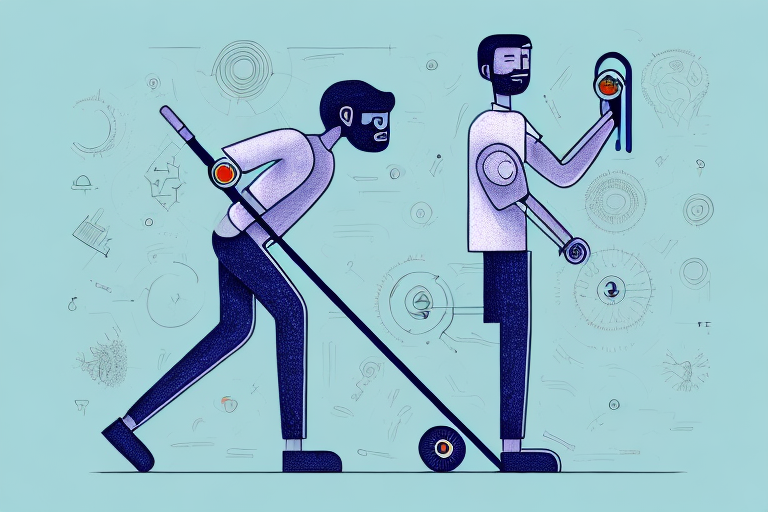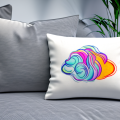If you’re someone who frequently works out, you’ve probably heard of muscle roller sticks, a popular massage tool used to alleviate muscle soreness and pain. These cylindrical tools come in different shapes and sizes, and are designed to target specific areas of the body, including the legs, arms, and back. In this article, we’ll explore the science, history, and benefits of muscle roller stick techniques, and provide you with a step-by-step guide for using them correctly.
Understanding the Science behind Muscle Roller Stick Techniques
Muscle roller stick techniques originated from the concept of self-myofascial release, a method of self-massage that addresses tightness in the body’s connective tissue. The connective tissue, called fascia, forms a network throughout the body that surrounds muscles, bones, and organs. When this tissue becomes tight or knotted, it can result in pain, inflammation, and limited mobility.
Using a muscle roller stick on these areas applies pressure to the fascia, breaking up adhesions and promoting blood flow to the affected muscles. This can help alleviate soreness, reduce inflammation, and increase range of motion. Additionally, the pressure from rolling can stimulate the release of endorphins, the body’s natural pain relievers, providing a sense of relaxation and comfort.
Research has also shown that using a muscle roller stick can improve muscle performance and aid in recovery after exercise. By increasing blood flow to the muscles, the body is able to deliver more oxygen and nutrients to the affected area, which can help reduce muscle fatigue and soreness. Additionally, using a muscle roller stick before exercise can help warm up the muscles and prepare them for activity, while using it after exercise can help flush out metabolic waste and reduce the risk of injury.
The History of Muscle Roller Stick Techniques and its Evolution
The concept of self-myofascial release has been around for centuries, with evidence of similar techniques found in ancient Chinese medicine and Greek athletics. In the 1980s, foam rollers gained popularity in the fitness community as a tool for self-massage, providing similar benefits to muscle roller sticks.
However, muscle roller sticks have since evolved to offer a more targeted approach to self-massage. The use of pressure points and different shapes and sizes allows for specific targeting of muscle groups, making muscle roller sticks a more customizable and effective tool for improving muscle health.
Recent studies have also shown that using muscle roller sticks can help improve flexibility, reduce muscle soreness, and increase range of motion. This is because the pressure applied by the roller stick helps to break up adhesions and knots in the muscles, allowing for better blood flow and nutrient delivery to the affected areas.
How Muscle Roller Stick Techniques Help in Relieving Muscle Pain and Soreness
Muscle roller stick techniques have been shown to be particularly effective in relieving delayed onset muscle soreness, or DOMS. DOMS is the pain and stiffness experienced in muscles 24-48 hours after strenuous exercise or physical activity. Rolling over affected muscle groups can help reduce this pain, promote healing, and improve overall muscle recovery.
In addition to post-workout recovery, muscle roller stick techniques can also be used for injury prevention by addressing tightness and adhesions in the muscles before they become problematic. Regular use of muscle roller sticks can also help with chronic muscle pain and stiffness, particularly in areas that are prone to tightness and soreness, such as the back or legs.
It is important to note that while muscle roller stick techniques can be beneficial for muscle pain and soreness, they should be used in conjunction with other forms of recovery and injury prevention, such as stretching, proper nutrition, and rest. It is also important to use the roller stick correctly, applying appropriate pressure and avoiding sensitive areas or joints. Consulting with a healthcare professional or certified trainer can help ensure safe and effective use of muscle roller sticks.
Different Types of Muscle Roller Sticks and Their Unique Benefits
There are various types of muscle roller sticks, each designed to address different muscle groups and areas of the body. Some popular varieties include:
- Basic smooth roller – Best for beginners, these rollers have a smooth surface and are designed to help with general muscle soreness and stiffness.
- Textured roller – These rollers have a bumpy or ridged surface, and are designed to provide a more intense massage and target specific trigger points in the muscles.
- Stick roller – These cylindrical rollers have handles on either end and are designed for more targeted pressure, particularly in areas like the calves or feet.
Step-by-Step Guide to Using a Muscle Roller Stick Correctly
When using a muscle roller stick, start with a light amount of pressure and adjust as needed. It’s important to avoid rolling over bony areas or joints, as this can cause discomfort or injury. Here’s a step-by-step guide to using a muscle roller stick:
- Begin in a seated or lying down position with the area you want to target exposed.
- Place the roller on the area and gently apply pressure.
- Roll the roller over the area, focusing on any tight or sore spots. Roll back and forth for 30-60 seconds at a time.
- Take deep breaths and relax during the massage, and adjust the pressure as needed.
- Repeat the process on all areas that need attention, taking care to avoid bone and joint areas.
Common Mistakes to Avoid While Using a Muscle Roller Stick
As with any fitness tool, there are potential risks associated with using a muscle roller stick incorrectly. Here are some common mistakes to avoid:
- Rolling over joints or bony areas
- Applying too much pressure, which can cause injury or soreness
- Using the roller on areas that are already inflamed or injured
Precautions to Take When Using a Muscle Roller Stick
While muscle roller stick techniques are generally safe, there are some precautions you can take to avoid injury or discomfort:
- Avoid using a muscle roller stick if you have an injury or inflammation in the targeted area
- Start with a smooth roller and gradually work up to more textured rollers and deeper pressure
- Use the roller on a padded or cushioned surface, such as a yoga mat
Combining Muscle Roller Stick Techniques with Other Methods for Maximum Benefit
Muscle roller stick techniques can be combined with other methods to enhance their effectiveness for muscle recovery and pain relief. For example, combining muscle roller stick techniques with stretching can improve flexibility and mobility, while using them with heat therapy can promote relaxation and blood flow.
Expert Tips for Incorporating Muscle Roller Stick Techniques into Your Fitness Routine
As with any fitness tool, consistency and proper form are key to seeing the benefits of muscle roller stick techniques. Here are some expert tips for incorporating muscle roller stick techniques into your fitness routine:
- Use a muscle roller stick both before and after workouts to prevent injury and aid in recovery
- Start with shorter sessions and gradually work your way up to longer sessions as your muscles become more accustomed to the pressure
- Use the muscle roller stick on all muscle groups, not just the ones that are sore or tight
Conclusion
Muscle roller stick techniques have become a popular self-massage tool for their ability to alleviate muscle soreness and pain. By understanding the science behind these techniques, choosing the right roller for your needs, and using them correctly and consistently, you can experience the many benefits of muscle roller stick techniques for improved muscle health and recovery.





